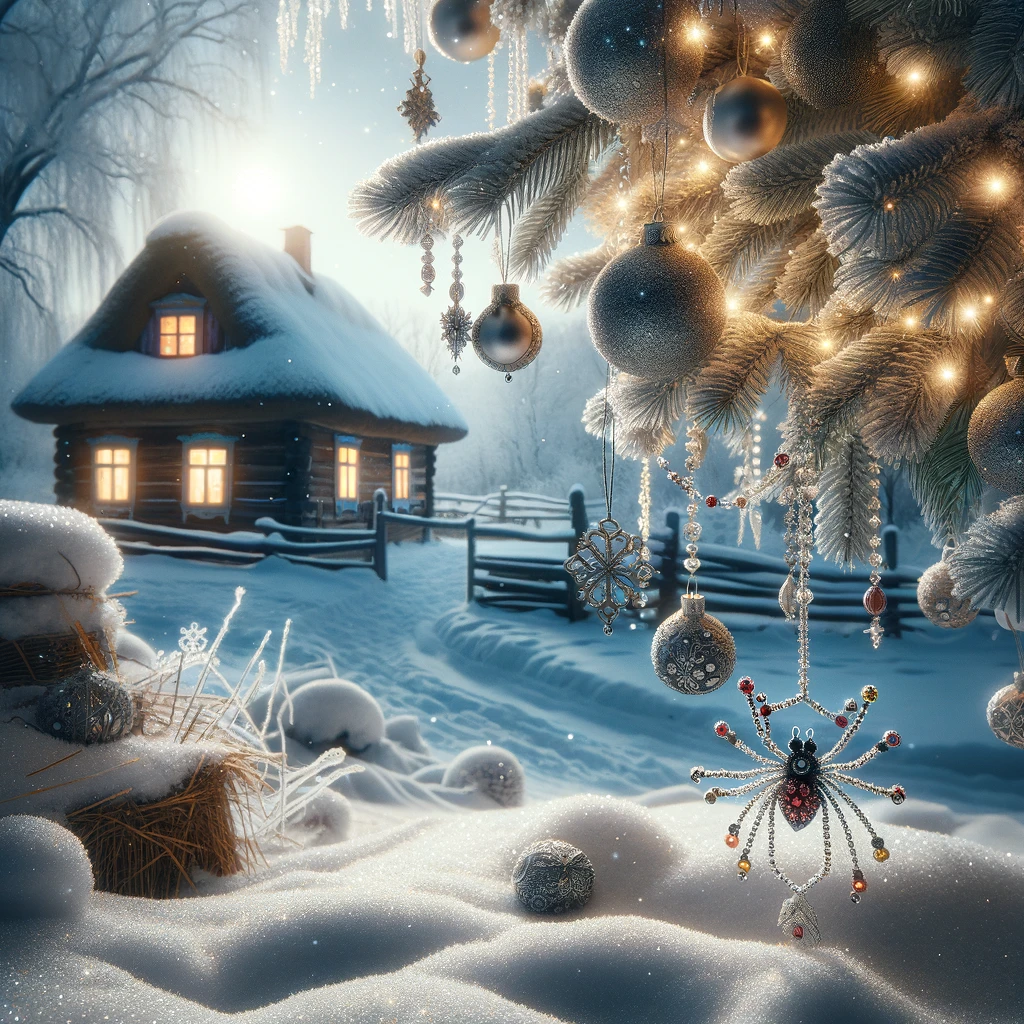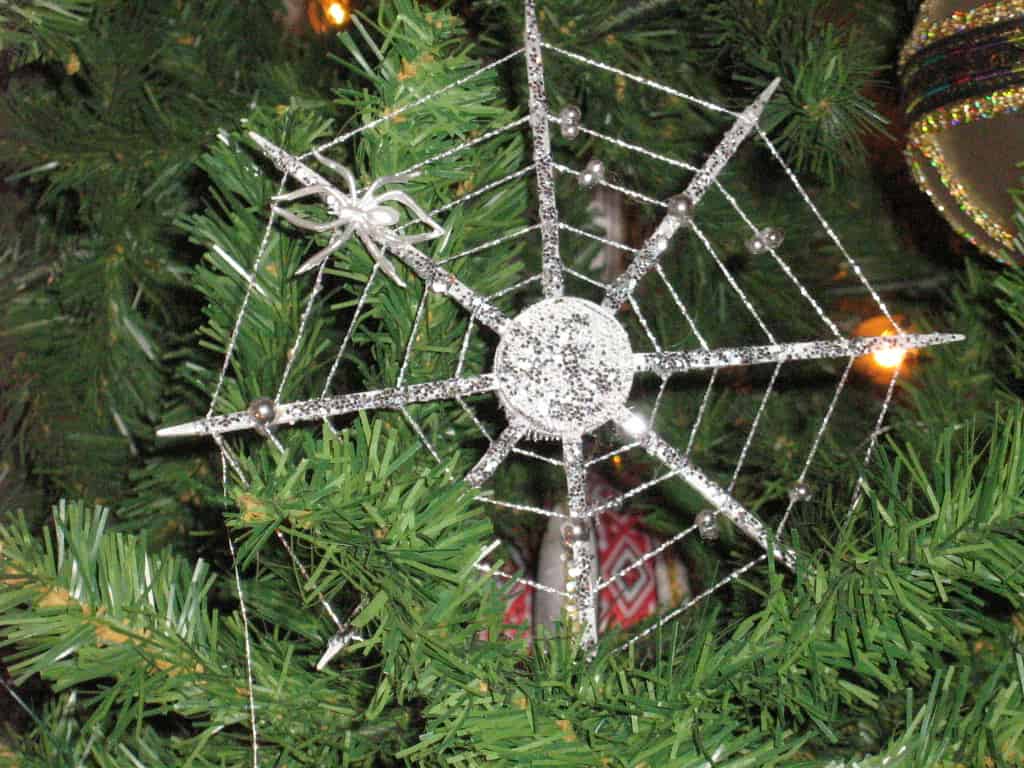Cobwebs and Christmas don’t seem to have much in common. But one legend, deeply rooted in Ukrainian tradition, brings them all together — and also explains why tinsel became a Christmas classic.

In the heart of winter, when the world is wrapped in a blanket of snow and the air is filled with the crisp scent of pine, most tales and legends are flashy. There’s the Yule season with its bonfire; the fearsome Wild Hunt in the sky; and of course, Santa delivering all the gifts.
But there’s another tale that often goes unheard in the bustling holiday season. It’s the story of Christmas spiders, a charming folklore that weaves its way through the fabric of our festive traditions. As you sit by the fire, sipping on hot cocoa, here’s the story of these mythical creatures and their place in Christmas lore.
The Origin of the Christmas Spider Legend
The legend of the Christmas spider varies across cultures, but its essence remains the same – transforming the ordinary into the extraordinary. In Germany and Ukraine, the story is a beloved part of Christmas folklore, and it is especially prevalent in Western Ukraine.
The fairy tale tells of a poor family who could not afford to decorate their Christmas tree. They were good people but stricken by poverty. Much as they tried, they couldn’t muster anything for decorations or ornaments. But on Christmas morning, they woke to find their tree covered in spider webs. These weren’t any old spiders, mind you — they were magic spiders.
When the first light of day touched the web, it turned into silver and gold. The children and family were overjoyed and they never lived in poverty again. This story symbolizes hope and the belief that miracles can happen, even in the most humble settings. But the underlying themes of the story stretch further.

The Symbolism of Spiders in History
To appreciate the Christmas spider, we must delve into the historical significance of spiders. In many cultures, spiders are revered as symbols of creativity, patience, and industriousness. Their ability to weave intricate webs is seen as a metaphor for the complexities of life. In Native American culture, the spider is often associated with storytelling and the interconnectivity of all things.
In European folklore, spiders carry a somewhat different meaning, although they are also sometimes linked to creation myths. Spiders symbolize patience. They are silent observers. That’s why, in other versions of the legend, the spiders play the main role. They see the family struggling, and they want to help. But they can only spin their webs and pray. Their prayer is answered by Father Christmas or Santa Claus, who turns the webs into silver and gold. In these stories, the Christmas spiders play unlikely main characters as protectors of the poor.
In some cultures, including Ukrainian, finding spiders or spider ornaments around the house, particularly around Christmas time, is considered good luck.
The influence of the Christmas spider is evident in holiday decorations around the world. In Eastern European countries, it’s common to find spider-shaped ornaments, known as ‘pavuchky’, adorning Christmas trees. These ornaments are often made of paper, wire, and beads, intricately crafted to resemble a spider in its web. They serve as a reminder of the Christmas spider’s tale and are believed to bring good luck and fortune to the household, making them popular gifts to exchange.
The practice of using tinsel for decorations around the holidays may also come from an ancient folktale. Tinsel, typically silver or gold, resembles the transformed spider webs in old versions of the Christmas spider story.
While the legend of the Christmas spider is steeped in folklore, let’s not forget the real-life spiders that inspired these tales as we head into the holidays. Spiders are fascinating creatures, playing vital roles in our ecosystems. As natural pest controllers, they help maintain the balance in our gardens and homes.
The Science Behind Our Arachnid Friends
Spiders are master architects, and many species spin their unique webs. The orb-weaver spider, for instance, crafts a classic spiral wheel-shaped web, a marvel of natural engineering. These webs, seen glistening with morning dew or frosted on a cold Christmas eve, are not just for catching prey; they’re also used for shelter and to attract mates. Their strength and resilience are subjects of extensive scientific research, with potential applications in various fields, including medicine and materials engineering.
There are over 45,000 known species of spiders, each with its distinct characteristics. From the tiny Samoan moss spider, barely larger than a pinhead, to the giant huntsman spider with its impressive leg span, the diversity within the arachnid world is astounding. This diversity, much like the varied traditions we see during the holidays, is a testament to the adaptability and evolutionary success of spiders.
As bioindicators, spiders help scientists assess the health of ecosystems. Changes in spider populations can indicate environmental shifts, such as pollution or climate change. This makes them essential allies in our understanding and preservation of natural habitats.
In agriculture, spiders are unsung heroes. They consume large quantities of agricultural pests, reducing the need for chemical pesticides. This natural form of pest control supports sustainable farming practices and promotes biodiversity.
Embracing the Spirit of the Christmas Spider
If you like this legend, you can probably find decorations or just use tinsel that reminds you of the Christmas spiders. But you can also create your own.
Creating your own Christmas spider ornaments can be a delightful family activity during the holidays. Using wire, beads, and other craft materials, families can come together on a chilly Christmas eve to make their own ‘pavuchky’ (or Christmas Spider) infusing them with personal meaning and continuing the tradition in their homes.
The Christmas spider has also found its way into literature and media, capturing the hearts of audiences with its folktale of hope and transformation. Children’s books and animated films often feature the Christmas spider, spreading its magical version of a festive story to new generations.
In the intricate web of life, the Christmas spider teaches us to find joy in the small wonders and to believe in the magic of the season. So, the next time you spot a spider or a spider’s web, perhaps during your holiday preparations, take a moment to appreciate these remarkable creatures and the rich folklore they’ve inspired. Merry Christmas, and may the legend of the Christmas spider bring hope, joy, and prosperity to your home.






